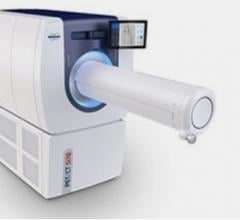June 11, 2013 — Siemens Healthcare has introduced Biograph mCT Flow, a positron emission tomography/computed tomography (PET/CT) system that, for the first time ever, overcomes the limitations of conventional bed-based PET/CT with FlowMotion, a new technology that moves the patient smoothly through the system’s gantry, while continuously acquiring PET data. Biograph mCT Flow with FlowMotion takes routine image quality to a new level by enabling imaging protocols based on the organ’s need.
FlowMotion expands quantification in all dimensions for precise disease characterization in therapy monitoring, while enabling physicians to offer as low as reasonably achievable (ALARA) dose to every patient. Additionally, the combination of a 78 centimeter bore with five-minute scanning and a continuous sense of progress throughout the scan provides the patient with a more comfortable exam experience.
Finest detail in every organ
With conventional PET/CT scanners, planning and scanning is limited to the fixed size of the system’s detector field of view (FOV) for each bed position. While the adjustment of scan parameters in clinical stop-and-go PET/CT protocols is technically possible, the complexity of adjustment has limited its routine use.
Biograph mCT Flow PET/CT with FlowMotion technology eliminates the need for stop-and-go, bed-based planning with planning and scanning based on the single continuous motion of the patient table. The technician can easily adjust the examination parameters such as speed, image resolution and motion management to the precise dimensions of organs and routinely incorporated into a single scan for every patient.
Accurate quantification in all dimensions
In order to help physicians make sound decisions, nuclear imaging must provide accurate and reproducible quantification. Conventional PET/CT suffers from intrinsic sensitivity degradation from the center to the edge of the axial FOV. Overlapping sequential bed positions are used to compensate for this constraint, but this approach can lead to axially varying noise sensitivity. This noise can distort the quantitative values of a detected lesion, which may prompt a physician to mischaracterize the severity of a tumor. By continuously moving the patient through the detection system, FlowMotion technology eliminates overlapping bed acquisitions and maintains uniform noise sensitivity across the entire scan range.
Minimum dose and maximum speed
FlowMotion eliminates CT dose due to overscanning by enabling the user to precisely define the beginning and end of the PET scan – and since the CT scan of Biograph mCT Flow begins and ends at the same points as the system’s PET scan, the patient is not irradiated in areas of the body that do not require a CT scan. With Biograph mCT Flow, the user can realize a CT dose reduction of up to 32 percent. Meanwhile, the new Biograph mCT Flow, coupled with TrueV, enables continuous scanning at twice the speed of conventional PET/CT. TrueV technology provides a 30 percent wider axial FOV of 21.6 cm, enabling Biograph mCT Flow to provide a 70 percent increase in count rate performance. When combined with ultraHD/PET, which delivers increased image quality, routine clinical scans can be performed in five minutes. The user can employ a simple protocol setup to determine the scan type and duration for up to four zones — for example, the head, lungs, abdomen and legs. The user can then tailor the scan in each region using Siemens’ established image quality techniques.
Open comfort for all patients
Healthcare providers require a system that accommodates the individual needs of a wide patient demographic. A standard PET/CT scan can last 25 to 30 minutes, with the patient frequently falling asleep or zoning out while the system acquires a bed position. When the bed shifts to the next scanning position, the patient is often startled, resulting in an image that is marred by motion artifacts. The patient also can feel anxiety during the lengthy scanning process, perceiving no progress until the bed shifts to a new scanning position.
In addition to the elimination of patient motion due to surprise, the continuously moving patient table of Biograph mCT Flow gives the patients a sense of progress, which can further enhance patient satisfaction. Additionally, the large 78 cm bore, short tunnel and a 500 pound table capacity can improve patient comfort and accessibility.
For more information: usa.healthcare.siemens.com


 June 23, 2025
June 23, 2025 









